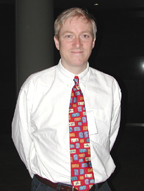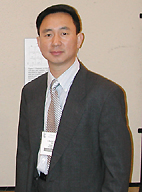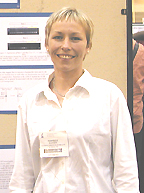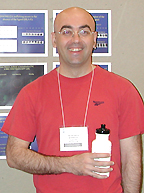

| T H E N I H C A T A L Y S T | M A Y – J U N E 2002 |
|
|
|
From the Meeting FieldMEMORIES ARE MADE OF THIS—AND THAT |
text and photos by Masashi Rotte, VRC
|
From time to time, the Catalyst reports on talks given by NIH intramural scientists at meetings held outside NIH. Masashi Rotte, a pre-IRTA at the VRC, attended the 11th annual Federation of American Societies for Experimental Biology meeting and wrote up a few of the presentations he heard. The theme of the meeting, which was held in New Orleans from April 20–24 and sponsored by seven U.S. and 24 international scientific societies, was "Translating the Genome." Nearly 15,000 biomedical researchers attended.
 |
 |
|
John Kelly
|
Chang-You-Wu
|
![]() Robert Seder,
chief of the VRC Cellular Immunology
Section, chaired a symposium on "Generation and Maintenance of Memory
Cells," at which NHLBI’s John
Kelly and the VRC’s
Chang-You-Wu
reported their findings. Kelly, of the Laboratory
of Molecular Immunology, examined memory CD8 T- cell maintenance in a group
of Stat5a knockout mice and in another group of Stat5a knockout mice
that were transgenic for Stat5b.
Robert Seder,
chief of the VRC Cellular Immunology
Section, chaired a symposium on "Generation and Maintenance of Memory
Cells," at which NHLBI’s John
Kelly and the VRC’s
Chang-You-Wu
reported their findings. Kelly, of the Laboratory
of Molecular Immunology, examined memory CD8 T- cell maintenance in a group
of Stat5a knockout mice and in another group of Stat5a knockout mice
that were transgenic for Stat5b.
The Stat family of proteins are involved in cytokine signaling through the intracellular Jak-Stat pathway. Kelly found that Stat5a knockout mice had decreased numbers of CD8+ memory cells compared with the control wild-type mice, but the Stat5a knockouts that were Stat5b transgenic had increased numbers of CD8+ memory cells. In addition, the CD8+ T cells of the transgenic group showed increased proliferation in response to IL-15, a cytokine that signals through Stat5a and Stat5b. Kelly noted that he did not expect the Stat5a knockout to have such a profound effect on CD8 cells.
 |
|
Pernille Hansen
|
Wu, a staff scientist, reported that IL-12 is not essential to sustain memory Th1 cells in vivo. The cytokine IL-12, which is crucial in the induction of naive CD4 cells to Th1 cells, was knocked out of mice on a Balb/c background. Antigen-specific Th1 cells were generated in vitro and adoptively transferred to wild-type and knockout mice. Wu found that the adoptively transferred cells persisted as memory cells in vivo in equivalent frequencies in both wild- type and IL-12-/- animals at various time points over four months. However, the IL-12-/- Th1 memory cells generated less vigorous Th1 responses upon antigenic restimulation. Wu’s results indicate that IL-12, while not necessary to maintain Th1 memory cells in vivo, may be required for the preservation of Th1 responses.
![]() Pernille
Hansen, a visiting Fellow from Denmark in the NIDDK Metabolic
Diseases Branch, presented a poster on "Plasma Renin Activity in Adenosine
1 Receptor Deficient Mice: Effect of Salt Intake and Genetic Background."
Renin, a plasma enzyme, is secreted in response to low plasma sodium content
and/or low blood volume. As a result, renin can affect blood pressure and sodium
excretion. Hansen, with colleagues Josephine
Briggs and Jurgen
Schnermann, examined the potential role of adenosine 1 receptor (A1AR) in
the control of plasma renin. The investigators regulated salt content in the
diet of wild-type and A1AR knockout mice and then measured plasma renin
activity.
Pernille
Hansen, a visiting Fellow from Denmark in the NIDDK Metabolic
Diseases Branch, presented a poster on "Plasma Renin Activity in Adenosine
1 Receptor Deficient Mice: Effect of Salt Intake and Genetic Background."
Renin, a plasma enzyme, is secreted in response to low plasma sodium content
and/or low blood volume. As a result, renin can affect blood pressure and sodium
excretion. Hansen, with colleagues Josephine
Briggs and Jurgen
Schnermann, examined the potential role of adenosine 1 receptor (A1AR) in
the control of plasma renin. The investigators regulated salt content in the
diet of wild-type and A1AR knockout mice and then measured plasma renin
activity.
 |
|
Booki Min
|
To their surprise, there were no significant differences in activity between the wild-type and knockout mice fed a normal salt diet and no regulation of plasma renin activity in response to a change in the salt content of the diet in the A1AR knockout. They concluded that A1AR does not have a significant effect on plasma renin activity and its regulation by salt intake. Hansen said she plans to investigate the dependence of A1AR expression levels on dietary salt content and the effects of angiotensin receptor on plasma renin.
![]() Booki
Min, of the NIAID Laboratory
of Immunology, summarized his work on memory CD4+ T cells in his poster
on "Neonates Support ‘Homeostatic’ T Cell Proliferation."
Using neonatal mice as a host and model for lymphopenia, Min adoptively transferred
CD4 single positive thymocytes and purified naïve CD4+ T cells into the
host and tracked the proliferation of the transferred cells.
Booki
Min, of the NIAID Laboratory
of Immunology, summarized his work on memory CD4+ T cells in his poster
on "Neonates Support ‘Homeostatic’ T Cell Proliferation."
Using neonatal mice as a host and model for lymphopenia, Min adoptively transferred
CD4 single positive thymocytes and purified naïve CD4+ T cells into the
host and tracked the proliferation of the transferred cells.
 |
|
Francisco Borrego
|
Even in the absence of antigen, nearly one-fifth of the transferred cells divided seven or more times over a two-week period. The progeny cells had high levels of CD44 expression and produced IFN-g, indicating a memory phenotype. It was determined that the frequency of progeny cells could be diminished by increasing the number of CD4+ cells in the initial adoptive transfer; the frequency was increased by thymectomy. In this neonatal model, Min said, CD4 T cells "undergo a proliferative process that generates a population of memory CD4 T cells."
He plans to further explore what is driving the CD4+ cell division in the absence of antigen, the role of cytokines in the division, and whether divided and nondivided cell populations respond equally to antigenic stimulation.
![]() Francisco
Borrego, of the NIAID Laboratory
of Allergic Diseases, presented a poster explaining how "CD94/NKG2A
Recycling and Transmission of the Inhibitory Signal are Independent Processes."
Borrego analyzed the trafficking of CD94/NKG2A, a receptor expressed by NK cells
that binds the nonclassical MHC I molecule HLA-E. Using a labeled antibody and
a confocal microscope to track the receptor, he found that the receptor was
continuously cycling between the cell surface and an as-yet-to-be-identified
intracellular compartment.
Francisco
Borrego, of the NIAID Laboratory
of Allergic Diseases, presented a poster explaining how "CD94/NKG2A
Recycling and Transmission of the Inhibitory Signal are Independent Processes."
Borrego analyzed the trafficking of CD94/NKG2A, a receptor expressed by NK cells
that binds the nonclassical MHC I molecule HLA-E. Using a labeled antibody and
a confocal microscope to track the receptor, he found that the receptor was
continuously cycling between the cell surface and an as-yet-to-be-identified
intracellular compartment.
Using various biochemical
inhibitors, he also demonstrated that CD94/NKG2A traffics differently from other
NKG2 receptors and likely uses the cytoskeleton to move around the cell. Because
CD94/NKG2A has an inhibitory effect on NK cells, this receptor may be important
in the study of NK cell responses in tumor rejection and viral infection, he
said. He will pursue this research to determine the compartment that CD94/NKG2A
cycles to and whether this cycling is necessary for the receptor’s function.
![]()